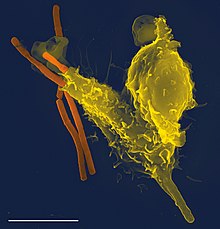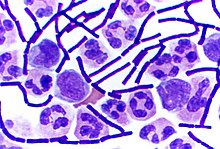Bacillus anthracis
| Bacillus anthracis | ||||||||||||
|---|---|---|---|---|---|---|---|---|---|---|---|---|

Bacillus anthracis |
||||||||||||
| Systematics | ||||||||||||
|
||||||||||||
| Scientific name | ||||||||||||
| Bacillus anthracis | ||||||||||||
| Cohn 1872 |

Bacillus anthracis (to Latin Bacillus , and to anthracis , from Greek ἄνθραξ , anthrax , "coal") is the causative agent of anthrax . The bacterium belongs to the group of gram-positive bacteria and, together with other bacteria, formsthe Bacillaceae family .
morphology

The anthrax bacterium is a relatively large (1-6 micrometer), facultative anaerobic , immobile rod-shaped bacterium that is mainly transmitted through endospores . The spores themselves form in the slightly tapered center of the rod, the bacteria typically join together to form chains or threads that look bamboo-like . In vivo (in the body) the bacterium forms a capsule made of polyglutamyl , which protects it from phagocytosis by the mononuclear phagocytic system (MPS). This capsule is usually missing in the culture on blood agar .
Bacillus anthracis has a high proportion of branched fatty acid chains (83%) .
transmission
The bacteria survive in the soil in spore form for decades. If they are ingested by herbivorous mammals such as cattle , sheep and pigs while they are eating, they begin to reproduce in the animal, kill the animal and continue to reproduce in the carcass, only to revert to the spore stage when the reproductive situation becomes unfavorable. Therefore, animals that have died of anthrax must not be buried, but must be cremated. The spores can also survive for a long time in the fur or on the skin of the animals. Epidemics of the disease are often directly related to animal husbandry or the processing of animal products. Furriers, tanners, milkers and veterinarians are particularly vulnerable occupational groups. It is a recognized occupational disease among farmers, butchers and veterinarians. There is generally no transmission from person to person.
Pathogenesis
The pathogenic properties of the bacterium can be traced back to two plasmids . The first (pXO1) codes, among other things, for the subunits of anthrax toxin and the second (pXO2) is responsible for the formation of polyglutamate capsules. The course of the disease is regulated by the absence of one of the plasmids.
clinic
- Lung anthrax: after inhalation of spore-containing dusts or aerosols, bronchopneumonia with high fever, bloody cough and hypoxia develops within a few days; fatal after 2–3 days.
- Skin anthrax: after direct contact of the skin with material containing pathogens, a papule and then an ulcer with black scabs develop .
- Intestinal anthrax: occurs after the consumption of undercooked meat from infected animals (very rare).
- Anthrax sepsis: mostly fatal complication of the various clinical manifestations of anthrax when disseminated through the bloodstream.
therapy
Immediate start of therapy if suspected (including prophylactic therapy for all potentially exposed persons) with ciprofloxacin or doxycycline . A number of monoclonal antibodies are now available as antitoxins and anthrax vaccines (USA, Great Britain) as prophylaxis .
history
Was discovered Bacillus anthracis in 1849 by Aloys Pollender . After Ferdinand Julius Cohn could only assume in 1874 that bacteria would cause anthrax, Robert Koch succeeded just two years later in multiplying the pathogen in culture for the first time and demonstrating its role in the development of the disease and the spores of the anthrax bacilli. Finally, in 1881, Louis Pasteur developed the first vaccine against the disease, which he successfully tested in a large-scale experiment on sheep. In 2002 the genome of the bacterium was completely sequenced .
Although Russia was a signatory and co-founder of the Biological Weapons Convention , the then Soviet Union operated a program for bioweapons research . In 1979, dozens of people died of anthrax in Sverdlovsk after gun-grade spore powder was accidentally released. The accident was covered up and civil civil protection institutions were not informed. Pathologists were able to show that the pathogen was not natural, so that the accidental release could no longer be denied. It was not until 1992 that the then Russian President Boris Yeltsin issued an official statement and a promise to shut down all active biological weapons programs.
Bioterrorism
Since the late 1990s, press reports have been increasing about the possible use of anthrax spores as a biological weapon in the context of international terrorism . In 2001, during a series of attacks in the USA, five people died as a result of contact with anthrax spores sent in letters. For an infection, however, a large amount of spores is required and a disease can usually be successfully treated by administering penicillin . As with all pathogens, the theoretically available possibility of genetically modifying the pathogen and thereby possibly making it more dangerous is discussed as a potentially serious threat .
Analytics
The Robert Koch Institute provides a freely available database including evaluation software based on Matlab and thus allows users of MALDI-TOF devices such as medical supply centers to screen patient material. The polymerase chain reaction is still necessary for confirmatory analysis in laboratories with a corresponding biological protection level .
Reporting requirement
In Germany, direct or indirect evidence is subject to notification by name in accordance with Section 7 of the Infection Protection Act if the evidence indicates an acute infection. The obligation to notify primarily concerns the management of laboratories ( § 8 IfSG).
In Switzerland, the positive and negative laboratory analytical finding is required to report for laboratories and indeed after the Epidemics Act (EpG) in connection with the epidemic Regulation and Annex 3 of the Regulation of EDI on the reporting of observations of communicable diseases of man .
literature
- RC Spencer: Bacillus anthracis . In: J Clin Pathol . , 56, 2003, pp. 182-187. Review. PMID 12610093
Web links
Individual evidence
- ↑ T. Kaneda: Iso- and anteiso-fatty acids in bacteria: biosynthesis, function, and taxonomic significance. In: Microbiol. Rev. 55 (2); June 1991, pp. 288-302. PMID 1886522
- ↑ Henrik Holtmann: BASICS Medical Microbiology, Virology and Hygiene . 3rd edition Urban & Fischer in Elsevier, Munich 2014, ISBN 978-3-437-42418-2 , pp. 56 .
- ↑ Andrea Naica-Loebell (2001): Anthrax and fear.
- ↑ Paul S. Keim, David H. Walker, Raymond A. Zilinskas: Biowaffen: The anthrax threat. In: Spektrum.de , November 23, 2017.
- ↑ Bioterror: The Anthrax Threat - Bacillus anthracis is at the top of the list of the most questionable biological weapons. What makes the anthrax pathogen so dangerous? Spektrum.de, November 20, 2017.
- ↑ Peter Lasch, Wolfgang Beyer, Herbert Nattermann, Maren Stämmler, Enrico Siegbrecht: Identification of Bacillus anthracis by Using Matrix-Assisted Laser Desorption Ionization-Time of Flight Mass Spectrometry and Artificial Neural Networks . In: Applied and Environmental Microbiology . tape 75 , no. 22 , November 15, 2009, ISSN 0099-2240 , p. 7229-7242 , doi : 10.1128 / aem.00857-09 , PMID 19767470 .
- ↑ Constance A. Bell, James R. Uhl, Ted L. Hadfield, John C. David, Richard F. Meyer: Detection of Bacillus anthracis DNA by LightCycler PCR . In: Journal of Clinical Microbiology . tape 40 , no. 8 , August 1, 2002, ISSN 0095-1137 , p. 2897-2902 , doi : 10.1128 / jcm.40.8.2897-2902.2002 , PMID 12149348 .

